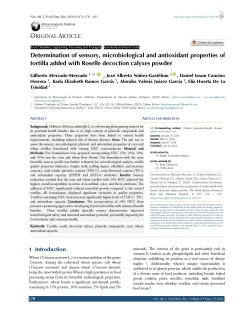Determination of sensory, microbiological and antioxidant properties of tortilla added with roselle decoction calyxes powder
Abstract
Background: Hibiscus (Hibiscus sabdariffa L.) is a flowering plant gaining interest for its potential health benefits due to its high content of phenolic compounds and antioxidant properties. These properties have been linked to various health improvements, including reduced risk of chronic diseases.
Aims: The aim was to assess the sensory, microbiological, physical, and antioxidant properties of corn and wheat tortillas formulated with varying HDC concentrations.
Material and Methods: Five formulations were prepared, incorporating HDC (5%, 20%, 50%, and 70%) into the corn and wheat flour blends. The formulation with the most favorable sensory profile was further evaluated for: microbiological analysis, tortilla quality properties (diameter, weight, yield, puffing degree, rollability, and moisture content), total soluble phenolic content (TSPCC), total flavonoid content (TFC), and antioxidant capacity (DPPH• and ABTS+• methods).
Results: Sensory evaluation revealed that the corn and wheat tortillas with 20% HDC achieved the highest overall acceptability in terms of mouthfeel, color, and flavor attributes. The addition of HDC significantly reduced microbial growth compared to the control tortillas. All formulations displayed significant variations in quality properties. Tortillas containing HDC demonstrated significantly higher levels of TSPCC, TFC, and antioxidant capacity.
Conclusion: The incorporation of 20% HDC flour presents a promising approach to developing functional tortillas with enhanced health benefits. These tortillas exhibit desirable sensory characteristics, improved microbiological safety, and increased antioxidant potential, potentially impacting the food industry and consumer health.
Keywords: Tortilla, Roselle decoction calyxes, phenolic compounds, corn, wheat, antioxidant capacity.
Full text article
Authors
Copyright (c) 2024 Gilberto Mercado, José Alberto Núñez Gastélum, Daniel Isram Cancino Herrera, Karla Elizabeth Ramos García, Alondra Valeria Juárez García, Elia Huerta de la trinidad

This work is licensed under a Creative Commons Attribution 4.0 International License.
-
Attribution — You must give appropriate credit, provide a link to the license, and indicate if changes were made. You may do so in any reasonable manner, but not in any way that suggests the licensor endorses you or your use.
-
No additional restrictions — You may not apply legal terms or technological measures that legally restrict others from doing anything the license permits.





